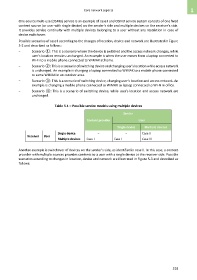Page 529 - 5G Basics - Core Network Aspects
P. 529
Core network aspects 1
One-source multi-use (OSMU) service is an example of case I and OSMU service system consists of one fixed
content source (or user with single device) on the sender's side and multiple devices on the receiver's side.
It provides service continuity with multiple devices belonging to a user without any restriction in case of
device switchover.
Possible scenarios of case I according to the changes of location, device and network are illustrated in Figure
5-2 and described as follows:
− Scenario ①: This is a scenario where the device is switched and the access network changes, while
user's location remains unchanged. An example is when the user moves from a laptop connected to
Wi-Fi to a mobile phone connected to WiMAX at home.
− Scenario ②: This is a scenario of switching device and changing user's location while access network
is unchanged. An example is changing a laptop connected to WiMAX to a mobile phone connected
to same WiMAX in an outdoor area.
− Scenario ③: This is a scenario of switching device, changing user's location and access network. An
example is changing a mobile phone connected to WiMAX to laptop connected to Wi-Fi in office.
− Scenario ④: This is a scenario of switching device, while user's location and access network are
unchanged.
Table 5-1 – Possible service models using multiple devices
Sender
Content provider User
Single device Multiple devices
Single device – – Case II
Receiver User
Multiple devices Case I Case I Case III
Another example is switchover of devices on the sender's side, as identified in case II. In this case, a content
provider with multiple sources provides contents to a user with a single device at the receiver side. Possible
scenarios according to changes in location, device and network are illustrated in Figure 5-3 and described as
follows:
519

